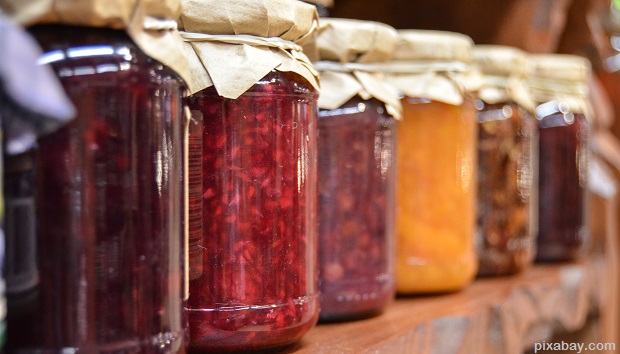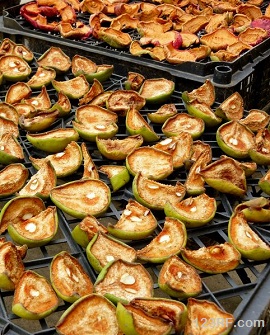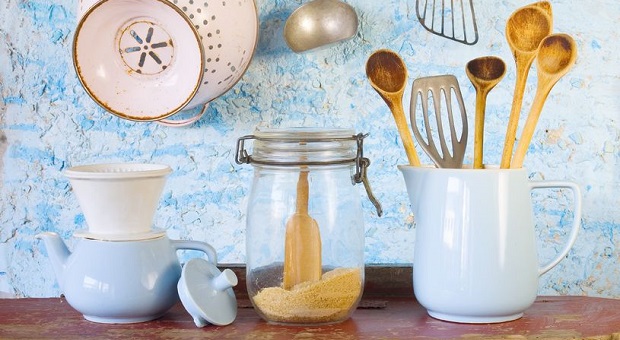So you’ve grown your garden and raised your chickens or cattle. Your herbs are ready to dry as are your beans and peppers. The question now is what are you going to do with it all? You have a ton of work ahead of you and having the proper tools is imperative.
If you want to build your stockpile and preserve all of the food that you’ve worked so hard on, you’re going to need some basic items for prepping your food at home.
One of the best ways to preserve food long-term is to can it. If you’re planning to can low-acid foods such as meat, dairy and most vegetables except for tomatoes, you need to do one of two things.
You need to either pickle these foods with vinegar or some other high-acid product or use a pressure canner to kill the botulinum bacteria in the food. Here is a list of items that you’ll need to can all of your foods:
Pressure canner – we recommend buying one of these because you can use it for both pressure canning and water-bath canning. It’s just a matter of using the lid or not.
Jar lifter – You absolutely must have these if you’re going to can your foods safely. You’ll use them to remove the jars from the hot water.
Jars – These come in a variety of sizes including half-pint, pint, quart and gallon. Using gallon jars is pretty rare though. Typically half-pint jars are used for jams, jellies, butter and preserves while pints and quarts are used for canning meats, fruits and vegetables. You can find these at most super stores or farm supply stores and they don’t cost very much.
Yard sales are another great place to find jars. Just make sure that if you buy them used, they have no chips or cracks.
Lids – Until recently, the only option that was available in canning lids was the single-use lids that had the rubber seal. Now there are a few different brands of reusable lids that can be used over and over again.
If you’re used to canning with standard disposable lids, you need to know that the reusable ones aren’t used in quite the same way. Just follow the instructions. The reusable ones are the ones that we recommend because if SHTF, you don’t want to run out of lids.
Rings – These are what you use to seal down the lids. They’re fairly durable and can be used multiple times as long as they maintain their physical integrity. In other words, make sure that your rings aren’t bent or rusted. You can find these in the same places that you buy your jars.

Kitchen Tongs – You’ll use these for taking the lids out of the hot water and for various other tasks.
Plastic or Stainless Steel Funnel – This needs to be a big-mouth funnel that will allow foods to pass through the opening into your jars. Funnels help keep the rims of your jars clean so that they’ll seal properly. You still need to wipe them but at least you won’t have food running down the sides of your jars. Don’t use aluminum.
Stainless Steel Ladle – You’ll use this to ladle your sauces and juices into the jars. Make sure that it has a long enough handle that you won’t get burned by the steam, but a short enough handle that you can manage it easily. Don’t use plastic or aluminum.
Magnetic Lid Lifter – This makes your life much easier and keeps from dropping the lid and risking contamination.
Scraper or other Bubble Remover – I’ve always actually used the handle to a plastic spoon or spatula for this but now you can buy a little scraper to run down the sides of your jars to remove bubbles after you have your food and liquid in the jars. This is important so that you lessen the risk of leaving excess air in the jar that will keep it from sealing.
Food Mill or Strainer – You may use your blender or food processor to puree your foods now but if you don’t have any electricity, this will come in handy to make your applesauce or strain your tomatoes. There are many other uses for it, too. Making fruit butters and straining impurities out of sauces are just a couple of them.
Kitchen towels – There are about a kazillion uses for kitchen towels when you’re canning. You’ll put some under the jars to keep the counters dry. You’ll put them over the hot jars to keep them from cooling to rapidly. You’ll need kitchen towels to clean off the rims of your jars and to wipe up the water that you drip when you’re moving jars.
You’ll also probably need a couple to wipe the sweat from your brow as you work over the heat. Use ones that are lint-free so that you don’t get lint on the rims of your jars that will prevent a proper seal.
Ok, that’s about all of the equipment, other than a heat source, that you’ll need for canning your food.
Dehydrating Food
 Dehydrating your food with power is a piece of cake but there are still some pieces of equipment that you’ll find useful.
Dehydrating your food with power is a piece of cake but there are still some pieces of equipment that you’ll find useful.
A Dehydrator – This is logical, but the type that you choose makes a big difference in drying time. They come in different wattages so which one you use depends upon how quickly you want your food to dry. A lower wattage one will obviously dry more slowly. How many racks you use will also play a role in how long it takes for the process to be complete.
Fruit Tray – This is just a piece of thin plastic that goes right on the rack of the dehydrator. You use it to make fruit leather that are sort of like fruit roll-ups. You can also use it to make jerky if you prefer to make a paste of your meat instead of slicing it thinly.
Sharp Knife – In order to slice your meat thinly enough to make jerky, you’re going to need an extremely sharp kitchen knife. Go for one with a blade at least 6 inches long so that you can cut through the roasts easily in one slice.
Baking Sheet – If you’re not going to use a dehydrator, you can always dehydrate your food in the oven by placing it in a single layer on a baking sheet and leaving it in the oven at extremely low heat for several hours.
Food Mill – Ahhh…here’s another reason to have a food mill. You’ll need it to make your fruit leather if you don’t want to (or can’t) use your blender or food processor
Vacuum Sealer – Though dehydration does slow the spoiling process, it doesn’t stop it completely. By vacuum sealing your dehydrated food, you’ll extend the shelf life of it considerably. You can also store it in baggies or plastic containers if you’re going to eat it quickly or you may can it for long-term storage.
These are just items that are necessary for preserving foods. If you just want to stock your kitchen with items that you’ll need on a daily basis, here’s a good starter list:
- Several different sizes of iron skillets
- Dutch oven
- Stainless steel spatula
- Stainless steel ladle
- Several wooden spoons
- Stainless steel slotted spoon
- Kitchen shears
- A knife set that contains a paring knife, a butcher knife, a chef’s knife and steak knives
- A boning knife
- Several different sizes of stainless steel pots, including 2 quart, 4 quart, 6 quart and 12 quart.
- 4-sided grater
- Flour sifter
- Measuring spoons and cups for dry goods
- 2-cup glass measuring cup for liquids
- A well-rounded variety of spices
- Salt
- Pepper
- Apple cider and white vinegar
- A variety of oils, including olive oil and coconut oil
These are just basic items that you need for preparing food at home. I have, no doubt, missed a few things so please feel free to add to the list in the comments section below.
Interested in becoming food-independent? CLICK HERE to find out more!
This article has been written by Theresa Crouse for Survivopedia.




































































Excellent suggestions, Please add to the list a couple of books for those who are new to food preservation. First, I recommend either the Ball or Kerr canning book. They update them occasionally and you can usually get them at the same places that you get your pressure canner, jars, etc. Then, I recommend one of the good books on pickling and fermenting. There are a bunch of them out there. One of the big pluses when you naturally ferment things like kraut (and you can “kraut” many vegetables) is that you neither have to water bath or pressure can your produce and the fermentation creates all the good little crittrs that keep your personal interior plumbing in good order.
I would only add one other item to this great list—a 4-cup measuring bowl and/or measuring cup. When doing large batches, this item can come in so handy and save time and effort. I have a pyrex measuring cup plus a 4 cup bowl. I have found myself using both when i get busy. Then again, I try to have duplicates of kitchen tools I use most often, especially for when I prepare food with a ‘helper’.
I would also recommend this list to anyone beginning life on their own.
Can’t use a food dehydrator if the no electricity. How about sheets on the roof- Ma Ingalls; window screens in the sun (or in the car!) – Starry Hilder. Me, I live in Texas and in the woods – no sun, and things left out mildew. Even my paper logs are mildewing outside. Arggh.